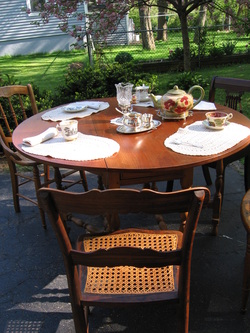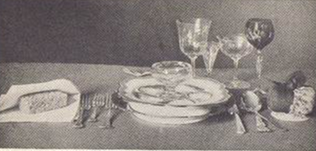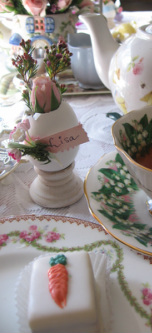 What does Arbor Day have to do with your table? Well if you sup upon a wooden one, of course your table's story began with a tree. Pictured with this post is my very special antique gateleg table on the very day that I received it five years ago. My dear friends helped me move it and before we brought it into the house, we enjoyed tea alfresco upon it as we celebrated its new chapter. I remember being keenly aware that this table, possibly one-two hundred years old, was steeped in story and it was an honor to continue it. The table came with remarkable clues. Not only was the table hand hewn, hand made without a single nail and 15 inch solid boards, but underneath I found a large J M woodburned into it and in pencil the following notes: Plymouth Table, restored in 1934 and refinished in 1972 with the names of the craftsmen recorded. Quite amazing. Although it is impossible to know any more details, it is fascinating to think about what forest the tree was hewn from, who JM was and to consider its story as it was shaped by hand into such a beautiful piece of fine furniture that became the centerpiece of its original home. Who sat around it? What meals were served upon it? What celebrations were marked? Whose feet wore away the lower rungs? What conversations were enjoyed upon it? Your own table has a story to tell and one yet to be told. It has been the scene of many memorable meals and it has been graced by many friends and family. Be intentional about the stories that are yet to be told. Draw out wonderful conversation by asking great questions and make sure everyone has the opportunity to share their story. The table is the foremost place we connect as a family. Since it is Arbor Day, why not ask some of these questions at your table today? What is one of your favorite trees and why? What important functions do trees uphold in our environment? What have been important trees in history? What items in your house have been made from trees? Additional ideas: * Read books about trees, children’s books, especially. “A Reverence for Wood” by Eric Sloane is a great one! * Visit the National Park, Marsh-Billings-Rockefeller estate in Woodstock Vermont to learn more about the fascinating history of tree conservation in New England. http://www.nps.gov/mabi/index.htm * Have your children research interesting tree facts and share them at the table. For example, did you know that the seeds of the Giant Redwoods are the size of the tomato seed? * Gather leaves and identify what trees they are from. * Read or write a tree poem. * Of course, plant a tree!
0 Comments
 We stand back a hundred years ago today to honor the tragedy and the triumph of all people connected with the Titanic. Lessons abound on every level, and in the midst of them, I offer one to you regarding the table. The lavishness of the dining table for the upper class reached its peak during the Edwardian era and the most extravagant meal was dinner. Everything about the meal was set in luxury and elegance including the table setting, dress, menu, etiquette, ambiance and table service. For example, the last dinner on the Titanic in the first class dining saloon consisted of at least eleven courses followed by after dinner cigars, coffee and cordials1. Tables were beautifully covered with pressed damask tablecloths ornamented with a vast array of precisely set table wares and floral arrangements. Upwards of fifty pieces of flatware alone could be used per person. Everyone dressed for dinner and it was an elaborate ceremony itself requiring valets and lady’s maids. The etiquette of the day required men to escort women to their places at the table, assist ladies with their chairs, stand each time they stood, and engage in conversation to the person to the right and left. Theses polite practices represented merely the overture in the symphony of etiquette which governed fine dining. All of this extravagance sank below the great depths that horrid night. What did prevail was the priority to save as many people as possible, and many heroically sacrificed their own lives in order to do so in hundreds of ways. We must remember at our tables that people are always most important, and every aspect of dining serves to cultivate these relationships. Dining etiquette is not about what fork to use, but about honoring those around your table. The most important part of a table setting is the person who sits before it. Focus on engaging rather than just eating. People, not possessions take priority. Relationships and not rules take precedence. © 2012 Lisa Steigerwalt 1Rick Archbold & Dana McCauley, Last Dinner On the Titanic, Madison Press Books, Toronto, Canada 1997, p. 67  Here is an simple way to personalize and adorn your Easter table with an egg cup vase as a place card. I don't know where I originally saw the idea, but it is a favorite of mine. It is a craft that your guests of all ages can make before dinner, or you can have them already made. A variation is to place a fluffy craft chick inside with the top of the eggshell as a cap! They can be used year after year! Materials: * Wooden egg pedestal (AC Moore Crafts) * Fresh Egg * Paper scraps, ribbon, buttons, tiny decorations * Dainty fresh flowers * Fluffy craft yellow chick (instead of flowers) * Glue Gun Here are the steps to make one: 1. Crack an egg near its top, and reserve egg for a recipe. Carefully rinse out egg and pat dry. Keep the little eggshell top you cracked off for the chick version. 2. Glue, using a hot glue gun, the egg cup to the pedestal. 3. Decorate the outside of the cup with ribbon, buttons, mini flowers, etc. 4. Write the person's name on a little piece of paper and glue. 5. FIll cup with water and arrange flowers or: 6. Tuck craft chick in and glue eggshell cap to its head as its top hat! On this great somber day of reflecting upon the Cross, one of the very powerful messages is that Jesus' life was not taken from Him, but that He laid it down for us. He Himself says that this is why He was born. And in doing so, it was and is the gateway to Life.
Another event we commemorate next weekend, the 100th year anniversary of the sinking of the Titanic, has similar strains of sacrifice ringing through it, not distinct from Good Friday, but rather an outpouring of it. Amidst the horrific tragedy of the ship's sinking, was the astounding sacrifice made for the lives of many women and children. "Women and children first" was the decree set forth by Captain Smith. It was not every person for himself, clambering to secure a precious seat in the insufficient number of life boats. Instead, "my life for yours" was courageously acted upon that day. In the certain face of death, many, and especially men, chose to die so that others might live to tell the story. Thinking about the nature of these sacrifices, I am reminded that this same truth is the foundation of etiquette and living a well-mannered life. The every day ways in which we treat one another are an opportunity to practice "my life for yours." Putting others first and regarding others as you would wish to be regarded, is this same principle of glorious sacrifice lived out in daily life. At the table we see how these thoughtful, sacrificial manners come to life as we serve one another: · Wait for your host or hostess to begin the meal and do not begin eating at will. · Honor the eldest woman by serving her first. · Be a good conversationalist by being more interested in the other person. · Don’t take the last serving of a dish unless it’s offered to you. · Serve others before you serve yourself. · Be certain to thank your host and hostess for the meal with sincere appreciation. |
Lisa Steigerwalt
Enriching home and family life, especially at the Table Archives
January 2014
Categories
All
|
 RSS Feed
RSS Feed